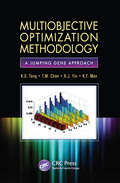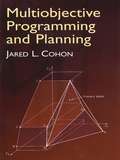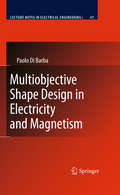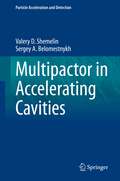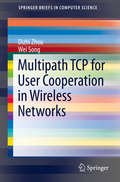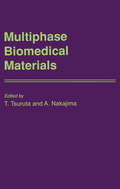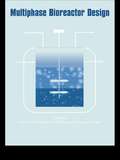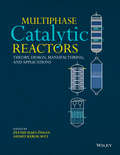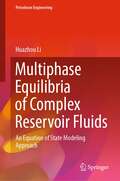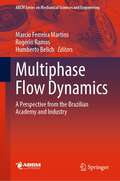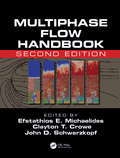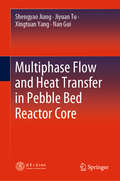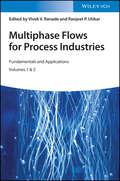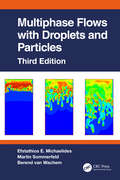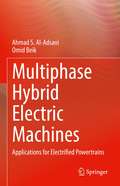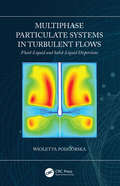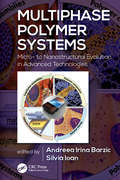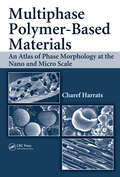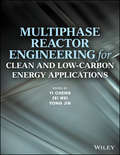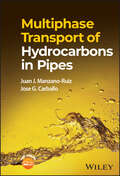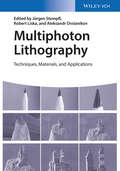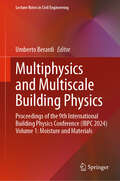- Table View
- List View
Multiobjective Optimization Methodology: A Jumping Gene Approach (Industrial Electronics)
by K.S. Tang T.M. Chan R.J. Yin K.F. ManThe first book to focus on jumping genes outside bioscience and medicine, Multiobjective Optimization Methodology: A Jumping Gene Approach introduces jumping gene algorithms designed to supply adequate, viable solutions to multiobjective problems quickly and with low computational cost. Better Convergence and a Wider Spread of Nondominated Solutions The book begins with a thorough review of state-of-the-art multiobjective optimization techniques. For readers who may not be familiar with the bioscience behind the jumping gene, it then outlines the basic biological gene transposition process and explains the translation of the copy-and-paste and cut-and-paste operations into a computable language. To justify the scientific standing of the jumping genes algorithms, the book provides rigorous mathematical derivations of the jumping genes operations based on schema theory. It also discusses a number of convergence and diversity performance metrics for measuring the usefulness of the algorithms. Practical Applications of Jumping Gene Algorithms Three practical engineering applications showcase the effectiveness of the jumping gene algorithms in terms of the crucial trade-off between convergence and diversity. The examples deal with the placement of radio-to-fiber repeaters in wireless local-loop systems, the management of resources in WCDMA systems, and the placement of base stations in wireless local-area networks. Offering insight into multiobjective optimization, the authors show how jumping gene algorithms are a useful addition to existing evolutionary algorithms, particularly to obtain quick convergence solutions and solutions to outliers.
Multiobjective Programming and Planning
by Jared L. CohonThis text takes a broad view of multiobjective programming, emphasizing the methods most useful for continuous problems. It reviews multiobjective programming methods in the context of public decision-making problems, developing each problem within a context that addresses practical aspects of planning issues. Topics include a review of linear programming, the formulation of the general multiobjective programming problem, classification of multiobjective programming methods, techniques for generating noninferior solutions, multiple-decision-making methods, multiobjective analysis of water resource problems, and multiobjective analysis of facility location problems. 1978 edition.
Multiobjective Shape Design in Electricity and Magnetism
by Paolo Di BarbaMultiobjective Shape Design in Electricity and Magnetism is entirely focused on electric and magnetic field synthesis, with special emphasis on the optimal shape design of devices when conflicting objectives are to be fulfilled. Direct problems are solved by means of finite-element analysis, while evolutionary computing is used to solve multiobjective inverse problems. This approach, which is original, is coherently developed throughout the whole manuscript. The use of game theory, dynamic optimisation, and Bayesian imaging strengthens the originality of the book. Covering the development of multiobjective optimisation in the past ten years, Multiobjective Shape Design in Electricity and Magnetism is a concise, comprehensive and up-to-date introduction to this research field, which is growing in the community of electricity and magnetism. Theoretical issues are illustrated by practical examples. In particular, a test problem is solved by different methods so that, by comparison of results, advantages and limitations of the various methods are made clear.
Multipactor in Accelerating Cavities (Particle Acceleration and Detection)
by Valery D. Shemelin Sergey A. BelomestnykhThis book is written by two world-recognized experts in radio frequency (RF) systems for particle accelerators and is based on many years of experience in dealing with the multipactor phenomenon. The authors introduce and review multipactor in RF cavities for scientists and engineers working in the field of accelerator physics and technology. The multipactor phenomenon of unintended electron avalanches occurs in the RF cavities commonly and quite often is a performance-limiting factor. The book starts with an Introductory Overview which contains historical observations and brief description of most common aspects of the phenomenon. Part I deals with the multipactor in a flat gap. It starts with description of the dynamics of electrons, derivation of the stability condition and analyzing influence of several factors on the multipactor. Then, the initial considerations are extended to derive a generalized phase stability and finally a particular case, called ping-pong multipacting, is considered. The part one is concluded with a brief review of computer codes used in multipactor simulations. Part II is dedicated to the multipactor in crossed RF fields, the typical situation in accelerating cavities. Two cases of MP are considered: a two-point multipactor near the cavity equator in elliptical cavities and a one-point multipactor. Part III describes optimization of the cavity shapes geared toward designing multipactor-free structures. The book will serve as an importance reference on multipactor for those involved in developing and operating radio frequency cavities for particle accelerators.
Multipath TCP for User Cooperation in Wireless Networks
by Wei Song Dizhi ZhouThis brief presents several enhancement modules to Multipath Transmission Control Protocol (MPTCP) in order to support stable and efficient multipath transmission with user cooperation in the Long Term Evolution (LTE) network. The text explains how these enhancements provide a stable aggregate throughput to the upper-layer applications; guarantee a steady goodput, which is the real application-layer perceived throughput; and ensure that the local traffic of the relays is not adversely affected when the relays are forwarding data for the destination. The performance of the proposed solutions is extensively evaluated using various scenarios. The simulation results demonstrate that the proposed modules can achieve a stable aggregate throughput and significantly improve the goodput by 1. 5 times on average. The brief also shows that these extensions can well respect the local traffic of the relays and motivate the relay users to provide the relaying service.
Multiphase Biomedical Materials
by T. Tsuruta A. NakajimaFollowing many reports that were published in the last two decades on correlations of multiphase structures of the surface of materials with their antithrombogenicity or biocompatibility a research project ''Design of Multiphase Biomedical Materials'' was carried out in Japan between 1982 and 1986. The objective of this research project was to elucidate various aspects of biomedical behaviour of multiphase systems at the interface with living bodies at the molecular, cellular and tissue levels. Multiphase materials studied cover polymers having microphase-separated structures, hydrogels, immobilized enzymes (or cells), ceramics and metallic materials. The research project was carried out by the following subgroups: -- Multiphase biomedical materials with microdomain structures -- Multiphase biomedical materials containing liquid components -- Hybrid-type multiphase biomedical materials with biological components -- Inorganic and metallic multiphase biomedical materials -- Methods for analysis and evaluation of multiphase biomedical materials This book contains the results of the research project in an edited form and aims to provoke a better understanding about various aspects of cell--material interactions in which the multiphase systems play a crucial role.
Multiphase Bioreactor Design
by Manuel Mota Joaquim M.S. Cabral Johannes TramperBioreaction engineering is fundamental to the optimization of biotechnological processes and the production of biochemicals by enzymes, microbial, plant and animal cells and higher organisms.A reference text for postgraduate students and researchers in biochemical engineering and bioreactor design, Multiphase Bioreactor Design describes the
Multiphase Catalytic Reactors: Theory, Design, Manufacturing, and Applications
by Zeynep Ilsen Önsan Ahmet Kerim AvciProvides a holistic approach to multiphase catalytic reactors from their modeling and design to their applications in industrial manufacturing of chemicals Covers theoretical aspects and examples of fixed-bed, fluidized-bed, trickle-bed, slurry, monolith and microchannel reactors Includes chapters covering experimental techniques and practical guidelines for lab-scale testing of multiphase reactors Includes mathematical content focused on design equations and empirical relationships characterizing different multiphase reactor types together with an assortment of computational tools Involves detailed coverage of multiphase reactor applications such as Fischer-Tropsch synthesis, fuel processing for fuel cells, hydrotreating of oil fractions and biofuels processing
Multiphase Equilibria of Complex Reservoir Fluids: An Equation of State Modeling Approach (Petroleum Engineering)
by Huazhou LiThis short monograph focuses on the theoretical backgrounds and practical implementations concerning the thermodynamic modeling of multiphase equilibria of complex reservoir fluids using cubic equations of state. It aims to address the increasing needs of multiphase equilibrium calculations that arise in the compositional modeling of multiphase flow in reservoirs and wellbores. It provides a state-of-the-art coverage on the recent improvements of cubic equations of state. Considering that stability test and flash calculation are two basic tasks involved in any multiphase equilibrium calculations, it elaborates on the rigorous mathematical frameworks dedicated to stability test and flash calculation. A special treatment is given to the new algorithms that are recently developed to perform robust and efficient three-phase equilibrium calculations.This monograph will be of value to graduate students who conduct research in the field of phase behavior, as well as software engineers who work on the development of multiphase equilibrium calculation algorithms.
Multiphase Flow Dynamics: A Perspective from the Brazilian Academy and Industry (Lecture Notes in Mechanical Engineering)
by Marcio Ferreira Martins Rogério Ramos Humberto BelichThis book presents isothermal and non-isothermal multiphase flows with and without phase change or chemical reactions. Six main axes of multiphase flow are covered in a strategic order: Multiphase Flow in Industry, Multiphase Flow Measurement and Instrumentation, Multiphase Flow With Phase Change & Chemical Reactions, Multiphase Flow Modeling, Experimental Multiphase Flow, and Wet and Dry Particulate Systems. Each part is opened by mini-reviews written by internationally prominent researchers from the academy and industry. The content is of interest to researchers and engineers working in mining, oil and gas, power, nuclear, chemical process, space, food, biomedical, micro and nanotechnology, and other industries.
Multiphase Flow Handbook (Mechanical and Aerospace Engineering Series)
by Efstathios E. Michaelides, Clayton T. Crowe and John D. SchwarzkopfThe Multiphase Flow Handbook, Second Edition is a thoroughly updated and reorganized revision of the late Clayton Crowe’s work, and provides a detailed look at the basic concepts and the wide range of applications in this important area of thermal/fluids engineering. Revised by the new editors, Efstathios E. (Stathis) Michaelides and John D. Schwarzkopf, the new Second Edition begins with two chapters covering fundamental concepts and methods that pertain to all the types and applications of multiphase flow. The remaining chapters cover the applications and engineering systems that are relevant to all the types of multiphase flow and heat transfer. The twenty-one chapters and several sections of the book include the basic science as well as the contemporary engineering and technological applications of multiphase flow in a comprehensive way that is easy to follow and be understood. The editors created a common set of nomenclature that is used throughout the book, allowing readers to easily compare fundamental theory with currently developing concepts and applications. With contributed chapters from sixty-two leading experts around the world, the Multiphase Flow Handbook, Second Edition is an essential reference for all researchers, academics and engineers working with complex thermal and fluid systems.
Multiphase Flow In Permeable Media
by Martin J. BluntHydrocarbon production, gas recovery from shale, CO2 storage and water management have a common scientific underpinning: multiphase flow in porous media. This book provides a fundamental description of multiphase flow through porous rock, with emphasis on the understanding of displacement processes at the pore, or micron, scale. Fundamental equations and principal concepts using energy, momentum, and mass balance are developed, and the latest developments in high-resolution three-dimensional imaging and associated modelling are explored. The treatment is pedagogical, developing sound physical principles to predict flow and recovery through complex rock structures, while providing a review of the recent literature. This systematic approach makes it an excellent reference for those who are new to the field. Inspired by recent research, and based on courses taught to thousands of students and professionals from around the world, it provides the scientific background necessary for a quantitative assessment of multiphase subsurface flow processes, and is ideal for hydrology and environmental engineering students, as well as professionals in the hydrocarbon, water and carbon storage industries.
Multiphase Flow and Heat Transfer in Pebble Bed Reactor Core
by Jiyuan Tu Shengyao Jiang Xingtuan Yang Nan GuiThis book introduces readers to gas flows and heat transfer in pebble bed reactor cores. It addresses fundamental issues regarding experimental and modeling methods for complex multiphase systems, as well as relevant applications and recent research advances. The numerical methods and experimental measurements/techniques used to solve pebble flows, as well as the content on radiation modeling for high-temperature pebble beds, will be of particular interest. This book is intended for a broad readership, including researchers and practitioners, and is sure to become a key reference resource for students and professionals alike.
Multiphase Flows for Process Industries: Fundamentals and Applications
by Vivek V. Ranade Ranjeet P. UtikarDiscover the cutting-edge in multiphase flows used in the process industries In Multiphase Flows for Process Industries: Fundamentals and Applications, a team of accomplished chemical engineers delivers an insightful and complete treatment of the state-of-the-art in commonly encountered multiphase flows in the process industries. After discussing the theoretical background, experimental methods, and computational methods applicable to multiphase flows, the authors explore specific examples from the process industries. The book covers a wide range of multiphase flows, including gas-solid fluidized beds and flows with phase change. It also provides direction on how to use current advances in the field to realize efficient and optimized processes. Filling the gap between theory and practice, this unique reference also includes: A thorough introduction to multiphase flows and the process industry Practical discussions of flow regimes, lower order models and correlations, and the chronological development of mathematical models for multiphase flows Comprehensive explorations of experimental methods for characterizing multiphase flows, including flow imaging and visualization In-depth examinations of computational models for simulating multiphase flows Perfect for chemical and process engineers, Multiphase Flows for Process Industries: Fundamentals and Applications is required reading for graduate and doctoral students in the engineering sciences, as well as professionals in the chemical industry.
Multiphase Flows with Droplets and Particles, Third Edition
by Efstathios E. Michaelides Martin Sommerfeld Berend van WachemMultiphase Flows with Droplets and Particles provides an organized, pedagogical study of multiphase flows with particles and droplets. This revised edition presents new information on particle interactions, particle collisions, thermophoresis and Brownian movement, computational techniques and codes, and the treatment of irregularly shaped particles. An entire chapter is devoted to the flow of nanoparticles and applications of nanofluids. Features Discusses the modelling and analysis of nanoparticles. Covers all fundamental aspects of particle and droplet flows. Includes heat and mass transfer processes. Features new and updated sections throughout the text. Includes chapter exercises and a Solutions Manual for adopting instructors. Designed to complement a graduate course in multiphase flows, the book can also serve as a supplement in short courses for engineers or as a stand-alone reference for engineers and scientists who work in this area.
Multiphase Hybrid Electric Machines: Applications for Electrified Powertrains
by Omid Beik Ahmad S. Al-AdsaniThis book provides an insight into the design, modeling, control, and application of multiphase hybrid permanent magnet machines for electrified powertrains in electric and hybrid electric vehicles. The authors present an overview of electric and hybrid electric vehicles, hybrid electric machine topologies, hybrid permanent magnet (HPM) machine design, multiphase hybrid machines, operation of multiphase generators in series hybrid electric vehicles (SHEV), and machine hardware build-up and testing. Readers will gain an understanding of multiphase machine configuration, their design, control, and recent applications, along with the benefits they provide, and learn general design steps, prototyping, and hardware build-up processes of multiphase electric machines. Multiphase Hybrid Electric Machines: Applications for Electrified Powertrains will be a valuable reference for undergraduate and graduate students, researchers, and practicing engineers, working on electric/hybrid electric vehicles, as well as electric machine applications in renewable energy systems specifically wind turbines, HVAC systems, robotics, and aerospace industry.
Multiphase Particulate Systems in Turbulent Flows: Fluid-Liquid and Solid-Liquid Dispersions
by Wioletta PodgórskaMultiphase Particulate Systems in Turbulent Flows: Fluid-Liquid and Solid-Liquid Dispersions provides methods necessary to analyze complex particulate systems and related phenomena including physical, chemical and mathematical description of fundamental processes influencing crystal size and shape, suspension rheology, interfacial area of drops and bubbles in extractors and bubble columns. Examples of mathematical model formulation for different processes taking place in such systems is shown. Discussing connections between turbulent mixing mechanisms and precipitation, it discusses influence of fine-scale structure of turbulence, including its intermittent character, on breakage of drops, bubbles, cells, plant cell aggregates. An important aspect of the mathematical modeling presented in the book is multi-fractal, taking into account the influence of internal intermittency on different phenomena. Key Features Provides detailed descriptions of dispersion processes in turbulent flow, interactions between dispersed entities, and continuous phase in a single volume Includes simulation models and validation experiments for liquid-liquid, gas-liquid, and solid-liquid dispersions in turbulent flows Helps reader learn formulation of mathematical models of breakage or aggregation processes using multifractal theory Explains how to solve different forms of population balance equations Presents a combination of theoretical and engineering approaches to particulate systems along with discussion of related diversity, with exercises and case studies
Multiphase Polymer Systems: Micro- to Nanostructural Evolution in Advanced Technologies
by Andreea Irina Barzic and Silvia IoanPhase morphology in multicomponent polymer-based systems represents the main physical characteristic that allows for control of the material design and implicitly the development of new plastics. Emphasizing properties of these promising new materials in both solution and solid phase, this book describes the preparation, processing, properties, and practical implications of advanced multiphase systems from macro to nanoscales. It covers a wide range of systems including copolymers, polymer blends, polymer composites, gels, interpenetrating polymers, and layered polymer/metal structures, describing aspects of polymer science, engineering, and technology. The book analyzes experimental and theoretical aspects regarding the thermal and electrical transport phenomena and magnetic properties of crucial importance in advanced technologies. It reviews the most recent advances concerning morphological, rheological, interfacial, physical, fire-resistant, thermophysical, and biomedical properties of multiphase polymer systems. Concomitantly the book deals with basic investigation techniques that are sensitive in elucidating the features of each phase. It also discusses the latest research trends that offer new solutions for advanced bio- and nanotechnologies. Introduces an overview of recent studies in the area of multiphase polymer systems, their micro- and nanostructural evolutions in advanced technologies, and provides future outlooks, new challenges and opportunities. Discusses multicomponent structures that offer enhanced physical, mechanical, thermal, electrical, magnetic, and optical properties adapted to current requirements of modern technologies. Covers a wide range of materials, such as composites, blends, alloys, gels and interpenetrating polymer networks. Presents new strategies for controlling the micro- and nanomorphology and the mechanical properties of multiphase polymeric materials. Describes different applications of multiphase polymeric materials in various fields, including automotive, aeronautics and space industry, displays, and medicine.
Multiphase Polymer- Based Materials: An Atlas of Phase Morphology at the Nano and Micro Scale
by Charef HarratsDuring the past 10 years a large variety of new multiphase polymer-based materials have been studied from a morphological point of view. Simultaneously, huge progress has been achieved in microscopy. These circumstances underline the need for a reference that delineates the differences of various types of nanostructures in multiphase polymer-based
Multiphase Reactor Engineering for Clean and Low-Carbon Energy Applications
by Fei Wei Yi Cheng Yong JinProvides a comprehensive review on the brand-new development of several multiphase reactor techniques applied in energy-related processes Explains the fundamentals of multiphase reactors as well as the sophisticated applications Helps the reader to understand the key problems and solutions of clean coal conversion techniques Details the emerging processes for novel refining technology, clean coal conversion techniques, low-cost hydrogen productions and CO2 capture and storage Introduces current energy-related processes and links the basic principles of emerging processes to the features of multiphase reactors providing an overview of energy conversion in combination with multiphase reactor engineering Includes case studies of novel reactors to illustrate the special features of these reactors
Multiphase Transport of Hydrocarbons in Pipes
by Juan J. Manzano-Ruiz Jose G. CarballoMultiphase Transport of Hydrocarbons in Pipes An introduction to multiphase flows in the oil and gas industry The term ‘multiphase flow’ refers to the concurrent flow of oil and/or gas, alongside other substances or materials such as production water, chemical inhibitors, and solids (e.g. sand). This is a critical topic in the oil and gas industry, where the presence of multiple flow phases in pipelines affects deliverability, generates serious complications in predicting flow performance for system design and operation, and requires specific risk mitigation actions and continuous maintenance. Chemical and Mechanical Engineers interested in working in this industry will benefit from understanding the basic theories and practices required to model and operate multiphase flows through pipelines, wells, and other components of the production system. Multiphase Transport of Hydrocarbons in Pipes meets this need with a comprehensive overview of five decades of research into multiphase flow. Incorporating fundamental theories, historic and cutting-edge multiphase flow models, and concrete examples of current and future applications. This book provides a sound technical background for prospective or working engineers in need of understanding this crucial area of industry. Readers will also find: Fundamental principles supporting commercial software Detailed tools for estimating multiphase flow rates through flowlines, wells, and more Integration of conservation principles with thermodynamic and transport properties Coverage of legacy and modern simulation models This book is ideal for flow assurance engineers, facilities engineers, oil and gas production engineers, and process engineers, as well as chemical and mechanical engineering students looking to work in any of these roles.
Multiphoton Lithography: Techniques, Materials, and Applications
by Jürgen Stampfl Aleksandr Ovsianikov Robert LiskaThis first book on this fascinating, interdisciplinary topic meets the much-felt need for an up-to-date overview of the field. Written with both beginners and professionals in mind, this ready reference begins with an introductory section explaining the basics of the various multi-photon and photochemical processes together with a description of the equipment needed. A team of leading international experts provides the latest research results on such materials as new photoinitiators, hybrid photopolymers, and metallic carbon nanotube composites. They also cover promising applications and prospective trends, including photonic crystals, microfluidic devices, biological scaffolds, metamaterials, waveguides, and functionalized hydrogels. By bringing together the essentials for both industrial and academic researchers, this is an invaluable companion for materials scientists, polymer chemists, surface chemists, surface physicists, biophysicists, and medical scientists working with 3D micro- and nanostructures.
Multiphoton Processes and Attosecond Physics
by Kaoru Yamanouchi Midorikawa KatsumiRecent advances in ultrashort pulsed laser technology have opened new frontiers in atomic, molecular and optical sciences. The 12th International Conference on Multiphoton Processes (ICOMP12) and the 3rd International Conference on Attosecond Physics (ATTO3), held jointly in Sapporo, Japan, during July 3-8, showcased studies at the forefront of research on multiphoton processes and attosecond physics. This book summarizes presentations and discussions from these two conferences.
Multiphysics Modeling with Application to Biomedical Engineering
by Z. YangThe aim of this book is to introduce the simulation of various physical fields and their applications for biomedical engineering, which will provide a base for researchers in the biomedical field to conduct further investigation. The entire book is classified into three levels. It starts with the first level, which presents the single physical fields including structural analysis, fluid simulation, thermal analysis, and acoustic modeling. Then, the second level consists of various couplings between two physical fields covering structural thermal coupling, porous media, fluid structural interaction (FSI), and acoustic FSI. The third level focuses on multi-coupling that coupling with more than two physical fields in the model. Each part in all levels is organized as the physical feature, finite element implementation, modeling procedure in ANSYS, and the specific applications for biomedical engineering like the FSI study of Abdominal Aortic Aneurysm (AAA), acoustic wave transmission in the ear, and heat generation of the breast tumor. The book should help for the researchers and graduate students conduct numerical simulation of various biomedical coupling problems. It should also provide all readers with a better understanding of various couplings.
Multiphysics and Multiscale Building Physics: Proceedings of the 9th International Building Physics Conference (IBPC 2024) Volume 1: Moisture and Materials (Lecture Notes in Civil Engineering #552)
by Umberto BerardiThis book contains selected papers presented at the 9th edition of the official triennial conference of the International Association of Building Physics (IABP), held in Toronto, Ontario, Canada on 25-27 July, 2024. The contents make valuable contributions to academic researchers and practioners of the building sector. Readers will encounter new ideas for realizing more efficient and resilient buildings and cities. The approach followed in the book aims to explore how building physics can be explored using multi domains and scales.
